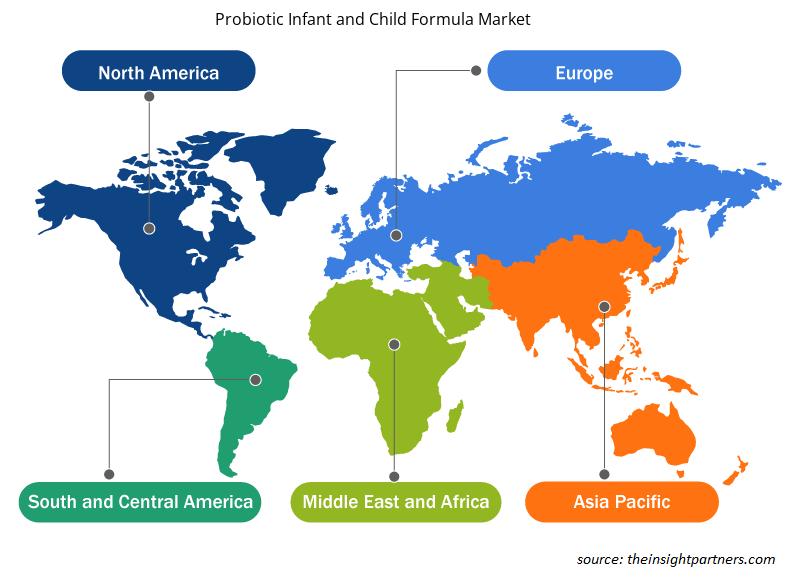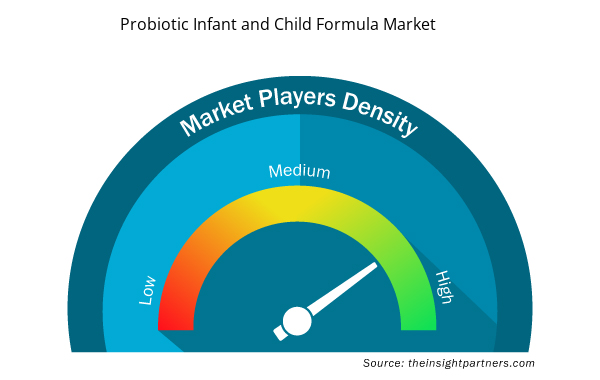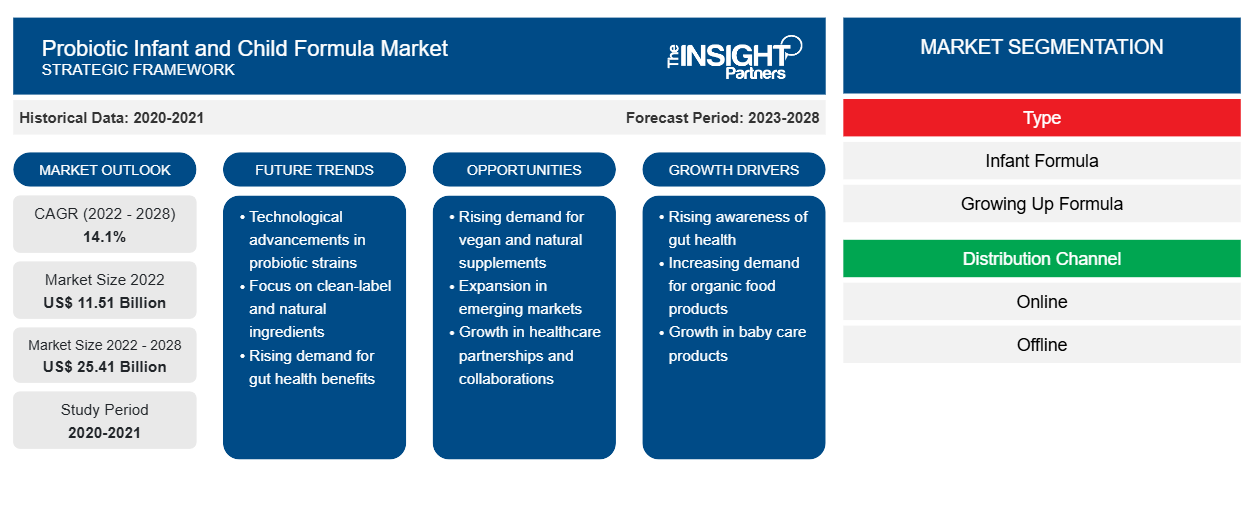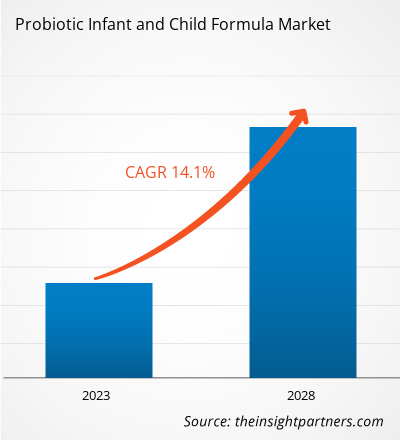益生菌婴幼儿配方奶粉市场预计将从 2022 年的 115.0528 亿美元增长至 2028 年的 254.1241 亿美元;预计 2022 年至 2028 年的复合年增长率为 14.1%。
益生菌婴幼儿配方奶粉是一种可替代母乳的工程食品。这些配方奶粉是最复杂的食品之一,因为它需要复杂的质量保证协议和特定的制造能力。由于人口不断增长,益生菌婴幼儿配方奶粉市场 正在经历显着增长。此外,亚太地区人民可支配收入的增加也鼓励了益生菌婴幼儿配方奶粉的接受。此外,快速的城市化和中产阶级的增长也推动了市场的增长。年轻职业母亲人数的增加推动了对益生菌婴幼儿配方奶粉的需求,因为她们主要依赖婴幼儿营养产品。
定制此报告以满足您的需求
您可以免费定制任何报告,包括本报告的部分内容、国家级分析、Excel 数据包,以及为初创企业和大学提供优惠和折扣
- 获取此报告的关键市场趋势。这个免费样品将包括数据分析,从市场趋势到估计和预测。
根据美国人口普查局的估计,2022年五岁以下儿童人口约为2480万,预计到2030年将增长至2520万。因此,6岁以下儿童人口的增加预计将推动对益生菌婴幼儿配方奶粉的需求。
市场洞察
职业女性人口增加推动益生菌婴幼儿配方奶粉市场增长
许多妇女在分娩后很快返回工作岗位。因此,婴儿配方奶粉等产品非常适合职业女性,因为它易于准备且耗时更少。此外,婴儿配方奶粉具有多种营养价值,如母乳,这增加了消费者对它的接受度。因此,职业女性人口的增加是推动益生菌婴儿和儿童配方奶粉需求的重要因素。中国是益生菌婴儿和儿童配方奶粉的最大市场之一。中国于 2016 年取消了数十年的独生子女政策。在人口普查数据显示出生率急剧下降后,中国政府于 2021 年 5 月宣布允许夫妇最多生育三个孩子。出生率的激增预计将导致对益生菌婴儿和儿童配方奶粉的需求增长。消费者对婴儿配方奶粉的购买行为发生了范式转变,父母表现出对优质和超优质婴儿配方奶粉的偏好,而不是传统配方奶粉。预计这一趋势将继续并推动益生菌婴儿和儿童配方奶粉市场的增长。
类型洞察
根据类型,益生菌婴幼儿配方奶粉市场分为婴儿配方奶粉(0-1 岁)和成长配方奶粉(1-6 岁)。2021 年,成长配方奶粉(1-6 岁)细分市场占据了市场主导地位。
雀巢公司、HiPP GmbH & Company Vertrieb KG、雅培实验室、美赞臣公司和贝拉米有机食品是益生菌婴幼儿配方奶粉市场的主要参与者。领先的参与者采用多种策略,例如并购和产品发布,以扩大其地理覆盖范围和消费者基础。
益生菌婴幼儿配方奶粉市场区域洞察
Insight Partners 的分析师已详细解释了预测期内影响益生菌婴幼儿配方奶粉市场的区域趋势和因素。本节还讨论了北美、欧洲、亚太地区、中东和非洲以及南美和中美洲的益生菌婴幼儿配方奶粉市场细分和地理位置。

- 获取益生菌婴幼儿配方奶粉市场的区域特定数据
益生菌婴幼儿配方奶粉市场报告范围
| 报告属性 | 细节 |
|---|---|
| 2022 年市场规模 | 115.1亿美元 |
| 2028 年市场规模 | 254.1亿美元 |
| 全球复合年增长率(2022 - 2028) | 14.1% |
| 史料 | 2020-2021 |
| 预测期 | 2023-2028 |
| 涵盖的领域 | 按类型
|
| 覆盖地区和国家 | 北美
|
| 市场领导者和主要公司简介 |
|
益生菌婴幼儿配方奶粉市场参与者密度:了解其对业务动态的影响
益生菌婴幼儿配方奶粉市场正在快速增长,这得益于消费者偏好的不断变化、技术进步以及对产品益处的认识不断提高等因素导致的终端用户需求不断增加。随着需求的增加,企业正在扩大其产品范围,进行创新以满足消费者的需求,并利用新兴趋势,从而进一步推动市场增长。
市场参与者密度是指在特定市场或行业内运营的企业或公司的分布情况。它表明在给定市场空间中,相对于其规模或总市场价值,有多少竞争对手(市场参与者)存在。
在益生菌婴幼儿配方奶粉市场运营的主要公司有:
- 雀巢公司
- HiPP 有限公司 Vertrieb KG
- 雅培实验室
- 美赞臣公司 (Mead Johnson & Company, LLC)
- 贝拉米有机
免责声明:上面列出的公司没有按照任何特定顺序排列。

- 了解益生菌婴幼儿配方奶粉市场的主要参与者概况
报告亮点
- 益生菌婴幼儿配方奶粉行业的发展趋势,帮助参与者制定有效的长期战略
- 公司采用的业务增长战略来确保发达市场和发展中市场的增长
- 2021-2028年全球益生菌婴幼儿配方奶粉市场定量分析
- 各行业对益生菌婴幼儿配方奶粉的需求预测
- 波特五力分析阐明了益生菌婴幼儿配方奶粉行业买家和供应商的效力
- 了解竞争激烈的市场形势以及对益生菌婴幼儿配方奶粉的需求的最新发展
- 市场趋势和前景以及影响益生菌婴幼儿配方奶粉市场增长的因素
- 了解与市场增长相关的商业利益战略,帮助决策过程
- 益生菌婴幼儿配方奶粉市场各节点规模
- 市场详细概述和细分以及行业动态
- 各地区益生菌婴幼儿配方奶粉市场规模及增长潜力巨大
“益生菌婴幼儿配方奶粉分析至 2028 年”是一项针对食品和饮料行业的专业深入研究,侧重于市场趋势分析。该报告旨在提供市场概述和详细细分。益生菌婴幼儿配方奶粉市场根据类型、分销渠道和地理位置进行细分。根据类型,市场细分为婴儿配方奶粉(0-1 岁)和成长配方奶粉(1-6 岁)。根据分销,益生菌婴幼儿配方奶粉市场细分为线上和线下。根据地理位置,市场细分为四个主要地区:北美、欧洲、亚太地区和世界其他地区。2021 年,亚太地区在益生菌婴幼儿配方奶粉市场中占据主导地位,预计在预测期内将实现市场最高复合年增长率。人们对营养需求的认识不断提高以及亚太地区出生率不断上升等因素推动了对益生菌婴幼儿配方奶粉的需求。
- 历史分析(2 年)、基准年、预测(7 年)及复合年增长率
- PEST 和 SWOT 分析
- 市场规模价值/数量 - 全球、区域、国家
- 行业和竞争格局
- Excel 数据集


- Predictive Maintenance Market
- Electronic Data Interchange Market
- Cell Line Development Market
- Volumetric Video Market
- Pharmacovigilance and Drug Safety Software Market
- Water Pipeline Leak Detection System Market
- Emergency Department Information System (EDIS) Market
- Microcatheters Market
- Thermal Energy Storage Market
- Automotive Fabric Market

Report Coverage
Revenue forecast, Company Analysis, Industry landscape, Growth factors, and Trends

Segment Covered
This text is related
to segments covered.

Regional Scope
North America, Europe, Asia Pacific, Middle East & Africa, South & Central America

Country Scope
This text is related
to country scope.
常见问题
Innovations in the probiotic infant and child formula market are the key trend for the global probiotic infant and child formula market. The probiotic infant and child formula is gaining intense competition in the global probiotic infant and child formula market is driving the focus toward product innovation.
Based on the type segment, growing-up formula (1-6 Years) was the fastest-growing segment in 2021. The growing up formula is a milk-based formula that is developed for children that are 1 year and 6 years of age. While it is not used as a meal replacement but as additional nutrition for children.
Based on the distribution channel, the online segment led the global probiotic infant and child formula market in 2021. Online retail is one of the fastest-growing distribution channels due to its shopping and product delivery convenience. Online retail stores offer a wide variety of products with heavy discounts; also, consumers can conveniently buy desirable products remotely.
Growing focus on infant care and nutrition and surge in the working women population is driving the probiotic infant and child formula industry. There has been substantial growth in the young working mother population. This has worked as a critical factor in propelling the growth of the probiotic infant formula market, as these working mothers are majorly dependent on processed infant nutrition products.
The major players operating in the global probiotic infant and child formula market are Nestlé S.A.; HiPP GmbH & Company Vertrieb KG; Abbott Laboratories; Mead Johnson & Company, LLC.; Bellamy's Organic
In 2020, Asia Pacific accounted for the largest share of the global probiotic infant and child formula market. The region is expected to exhibit significant growth during the forecast period due to increased purchases by new mothers on nutritious food for a child, accompanied by increasing people's purchasing capacity in this Asia Pacific region.
Trends and growth analysis reports related to Consumer Goods : READ MORE..
The List of Companies - Probiotic Infant and Child Formula Market
- Nestlé S.A.
- HiPP GmbH & Company Vertrieb KG
- Abbott Laboratories
- Mead Johnson & Company, LLC.
- Bellamy's Organic
- Aspen Pharmacare
- Beech-Nut
- Danone
- The Hain Celestial Group, Inc.
- Gerber
The Insight Partners performs research in 4 major stages: Data Collection & Secondary Research, Primary Research, Data Analysis and Data Triangulation & Final Review.
- Data Collection and Secondary Research:
As a market research and consulting firm operating from a decade, we have published and advised several client across the globe. First step for any study will start with an assessment of currently available data and insights from existing reports. Further, historical and current market information is collected from Investor Presentations, Annual Reports, SEC Filings, etc., and other information related to company’s performance and market positioning are gathered from Paid Databases (Factiva, Hoovers, and Reuters) and various other publications available in public domain.
Several associations trade associates, technical forums, institutes, societies and organization are accessed to gain technical as well as market related insights through their publications such as research papers, blogs and press releases related to the studies are referred to get cues about the market. Further, white papers, journals, magazines, and other news articles published in last 3 years are scrutinized and analyzed to understand the current market trends.
- Primary Research:
The primarily interview analysis comprise of data obtained from industry participants interview and answers to survey questions gathered by in-house primary team.
For primary research, interviews are conducted with industry experts/CEOs/Marketing Managers/VPs/Subject Matter Experts from both demand and supply side to get a 360-degree view of the market. The primary team conducts several interviews based on the complexity of the markets to understand the various market trends and dynamics which makes research more credible and precise.
A typical research interview fulfils the following functions:
- Provides first-hand information on the market size, market trends, growth trends, competitive landscape, and outlook
- Validates and strengthens in-house secondary research findings
- Develops the analysis team’s expertise and market understanding
Primary research involves email interactions and telephone interviews for each market, category, segment, and sub-segment across geographies. The participants who typically take part in such a process include, but are not limited to:
- Industry participants: VPs, business development managers, market intelligence managers and national sales managers
- Outside experts: Valuation experts, research analysts and key opinion leaders specializing in the electronics and semiconductor industry.
Below is the breakup of our primary respondents by company, designation, and region:

Once we receive the confirmation from primary research sources or primary respondents, we finalize the base year market estimation and forecast the data as per the macroeconomic and microeconomic factors assessed during data collection.
- Data Analysis:
Once data is validated through both secondary as well as primary respondents, we finalize the market estimations by hypothesis formulation and factor analysis at regional and country level.
- Macro-Economic Factor Analysis:
We analyse macroeconomic indicators such the gross domestic product (GDP), increase in the demand for goods and services across industries, technological advancement, regional economic growth, governmental policies, the influence of COVID-19, PEST analysis, and other aspects. This analysis aids in setting benchmarks for various nations/regions and approximating market splits. Additionally, the general trend of the aforementioned components aid in determining the market's development possibilities.
- Country Level Data:
Various factors that are especially aligned to the country are taken into account to determine the market size for a certain area and country, including the presence of vendors, such as headquarters and offices, the country's GDP, demand patterns, and industry growth. To comprehend the market dynamics for the nation, a number of growth variables, inhibitors, application areas, and current market trends are researched. The aforementioned elements aid in determining the country's overall market's growth potential.
- Company Profile:
The “Table of Contents” is formulated by listing and analyzing more than 25 - 30 companies operating in the market ecosystem across geographies. However, we profile only 10 companies as a standard practice in our syndicate reports. These 10 companies comprise leading, emerging, and regional players. Nonetheless, our analysis is not restricted to the 10 listed companies, we also analyze other companies present in the market to develop a holistic view and understand the prevailing trends. The “Company Profiles” section in the report covers key facts, business description, products & services, financial information, SWOT analysis, and key developments. The financial information presented is extracted from the annual reports and official documents of the publicly listed companies. Upon collecting the information for the sections of respective companies, we verify them via various primary sources and then compile the data in respective company profiles. The company level information helps us in deriving the base number as well as in forecasting the market size.
- Developing Base Number:
Aggregation of sales statistics (2020-2022) and macro-economic factor, and other secondary and primary research insights are utilized to arrive at base number and related market shares for 2022. The data gaps are identified in this step and relevant market data is analyzed, collected from paid primary interviews or databases. On finalizing the base year market size, forecasts are developed on the basis of macro-economic, industry and market growth factors and company level analysis.
- Data Triangulation and Final Review:
The market findings and base year market size calculations are validated from supply as well as demand side. Demand side validations are based on macro-economic factor analysis and benchmarks for respective regions and countries. In case of supply side validations, revenues of major companies are estimated (in case not available) based on industry benchmark, approximate number of employees, product portfolio, and primary interviews revenues are gathered. Further revenue from target product/service segment is assessed to avoid overshooting of market statistics. In case of heavy deviations between supply and demand side values, all thes steps are repeated to achieve synchronization.
We follow an iterative model, wherein we share our research findings with Subject Matter Experts (SME’s) and Key Opinion Leaders (KOLs) until consensus view of the market is not formulated – this model negates any drastic deviation in the opinions of experts. Only validated and universally acceptable research findings are quoted in our reports.
We have important check points that we use to validate our research findings – which we call – data triangulation, where we validate the information, we generate from secondary sources with primary interviews and then we re-validate with our internal data bases and Subject matter experts. This comprehensive model enables us to deliver high quality, reliable data in shortest possible time.


 获取此报告的免费样本
获取此报告的免费样本